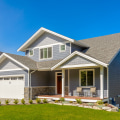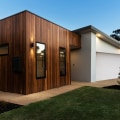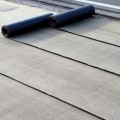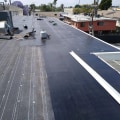Flat roofs have been around for centuries, and while they may not be as popular as sloped roofs, they still have their advantages and disadvantages. The biggest disadvantage of flat roofs is drainage or lack of it. Sure, flat roofs have a slight slope that drains water, but not as efficiently as a sloped roof. Rainwater tends to stay on the roof and form a puddle, which can cause potential leaks or material damage.
The same applies to the repair of a flat roof system. Patches are available for different flat roof systems, so they take less time to repair. If an asphalt shingle needs to be repaired, for example, if a tree branch punctured it, it is often necessary to repair surrounding shingles as well. You see, asphalt shingles are layered: half of one shingle is under the other, so there are always at least 2 layers of asphalt shingles anywhere on the roof.
Some people think that flat ceilings are less elegant than sloped roofs. In the middle of the 20th century, flat roofs were popular. Nowadays, even though they're less popular than pitched roofs, they're making a comeback. Flat roofs tend to be less stable, especially large flat roofs.
The larger the flat roof, the less stable it is. To compensate, additional structural stability must be incorporated into other areas of the building. Again, because there is no sloped roof and therefore no attic, there is less insulation space. Insulation is basically an empty space between the undesirable space (the outside) and the desirable space (the inside).
With a sloped roof, that insulation is your attic. With a flat roof, there is much less insulation. As a result, your home or building could be affected by extremely fluctuating temperatures. Drainage, or rather, the lack of it, is the biggest disadvantage.
Flat roofs don't drain as efficiently as sloped roofs. Water tends to accumulate and stay on the roof. Stagnant water can cause roofing material to break or future leaks, especially along the seams. A flat roof contractor is likely to install additional mechanisms to address proper drainage.
Water disposal options are time consuming and can be costly. While maintaining a flat roof is easier than maintaining a sloped roof, it is required much more often. Flat roofs don't drain properly if they aren't properly maintained, as drains can become clogged and cause leaks. Repairs can be costly if leaks occur, so be prepared for the need to periodically inspect your flat roof.
The most important advantage of a flat concrete roof is its resistance to strong winds. The disadvantages of the flat concrete roof include the need for additional support and the problems of chipping and discoloration. A disadvantage of a flat roof is the need to frequently remove snow in winter. In the case of non-ventilated flat roofs, the lack of ventilation and humidity would have to be added.
One of the drawbacks of flat roofs is that they are not the most adaptable to extreme temperature changes. While flat roofs can technically work anywhere, they should ideally work best in hot, dry climates like the Southwest, and not in areas with high humidity, snow, ice, and freezing temperatures. You'll probably need to pay more attention to a flat roof because of potential drainage issues. With a flat roof, you can anticipate the formation of puddles after a few days of rain if the roof itself is not planned or installed properly.
Flat roofs are also more energy efficient due to their membrane systems, which are applied over rigid insulating sheets. Investors planning to build a residential or commercial facility often think about whether a flat roof home is cheaper. We have also installed many flat roof systems in residential structures such as house extensions and detached garages. The specialized roof system consists of several layers including an ISO insulating plate, vapor barriers, commercial-grade metal borders, custom drains and a custom conical drain system to allow water to flow quickly from the low-sloped roof.
Depending on the magnitude of the damage to the flat roof repairs are often easier to perform than to a sloped roof. If you've thought about going greener and saving money on your energy bills a flat roof is the perfect place to install solar panels. Maintenance requires flat roof repair contractors to address shrinkage caused by prolonged exposure to UV rays. Unfortunately flat roofs receive more sunlight during the day because of their shape (which is flat).
Now that you know the common advantages and disadvantages of flat roofs it's time to look at some options. Commercial buildings often use their flat roofs to store HVAC units or other equipment out of sight but this extra space can be used as you see fit. A flat roof allows you to enjoy a warm climate with all the advantages of a regular roof but with a wide view. If you're building a modern house with a flat roof you're likely to choose between EPDM TPO or PVC membrane roofs or a liquid-applied roof system.
There are some homeowners who use flat roofs for years and there are some homeowners who realize that it's not right for them. If you think about it a completely flat roof will only accumulate rainwater quickly and will inevitably seep out. However to install units your roofing contractors must check the substructure to confirm the roof's capacity. Industrial buildings and businesses that have flat roofs have to compensate for the weight inside.



